
Office at Night, 1986. Victor Burgin.
In the past fifty years there has been exceptional interest among photographers in creating images rather than documenting actuality.
Manipulating concepts in creative photography in the 1970s attracted many practitioners due to the emergence of a commercial market for artistic photography.
Photographers have invented images by directing the action of subject before the lens, or manipulating photographic processes, or by mixing graphic, photographic, and electronic procedures. This reflects the experimentalist attitude prevailing in contemporary art as a whole.
Fragmented and reconstituted “realities” became visible on magazine pages, billboards, and television screens. Required the construction of sets, directing models, cropping, retouching, and combining photographs.
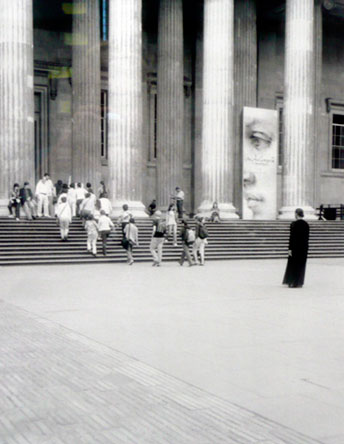
The Rivington Place. Carrie Mae Weems.
Photographic experimentalism has been influence of art directors and photography teachers, and promoted to a wide spectrum of students as techniques and ideas used in advertising.
In the US after WWII, artists working with unconventional materials (industrial paint, steel, plastics, pouring, staining and welding) ignored the distinction between various categories of visual expression.
Mixed media performances (part theatrical, part graphic, part photographic) and assemblages.
Photographers began to reevaluate assumptions regarding the distinctions between pure and documentary photography. New was of expression are considered.
Adopted new means that ranged from pairing and sequencing of straight camera images, to the invention of scenes to be photographed, to the manipulation of images either by manually reassembling portions of photographs or by intervening in optical and chemical processes.
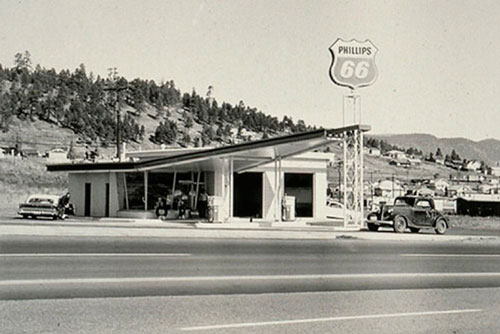
Gas station on Route 66, 1962. Ed Ruscha.
Conceptual photography is an approach that regards the photograph as uninflected records of information rather than emotionally nuanced experiences or works of fine art.
Idea has been to present photographers in pairs or sequences to parallel the way that photographs are commonly shown in picture journals or in advertising to the underline the point of view that how reality is frame in the camera depends on the inherent properties of the medium and on where the photographer is stationed.
The photograph is whatever the light reveals, the lens embraces, and the chemical substances make visible, and little to do with ultimate truths.
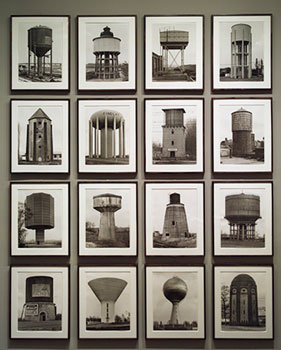
Watertowers, 1967–80. Bernd and Hilla Becher.
Producing a series of uninflected images of objects of the same sort arranged in an arbitrary sequence-sometimes called a “typology” constitutes another approach that avoids making a personal comment about the subject matter at hand.
California painter-photographer Edward Ruscha claimed to be providing “a catalog of neutral objective facts” when referring to a series of deadpan photographs of parking lots in Thirty-four Parking Lots in Los Angeles.
The images are suggestive of attitudes implicit in the “new topographics” bring to mind the repetition used in advertising photography to emphasize the abundance of material goods.
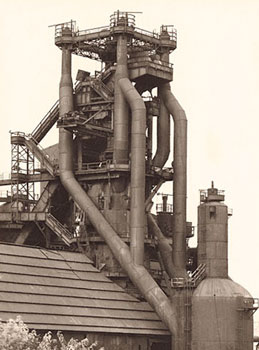
Blast Furnace, 1980. Bernd and Hilla Becher.
This approach attracted German photographers Bernd and Hilla Becher and Canadian Lynne Cohen.
Many typological images are appealing for their architectonic qualities, relating the work of Minimalists who were engaged in producing serial, geometric painting and sculpture during the 1960s.
Concentrated on size, shape, materials, and topography of industrial structures in England, France, Germany and The US. Bechers claim to be documenting similarities rather than celebrating distinctiveness.
Demonstrate how camera images can provide visual detail that the human eye might be able to take in only over a long period of familiarity with an object. Makers of such informational images disavowed aesthetic intentions.
Physical and psychological aspects of the architectural experience cannot be fully apprehended through photograph. A reaction to this is Judith Turner and dealing with dynamic qualities of geometric shapes and forms in buildings and signage rather than with the actuality of spatial entities.
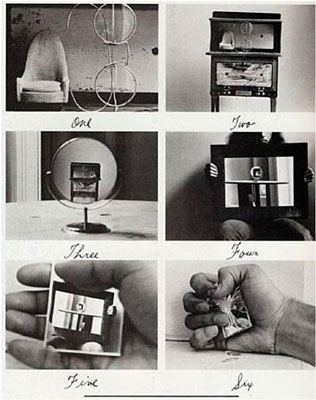
Alice’s Mirror, 1978. Duane Michals.
Photographers also use sequences often combined with texts of their own devising as a way of communicating subjective experience or commenting on cultural attitudes.
Revealing private realities such as Duane Michals, emphasized the primacy of subjective vision. Creator of fictions rather than of documents in the mid 1970s.
Michals first began to write and then to paint on his photographs, thereby suggesting that the artist may have to go beyond what the camera lens sees in order to deal with phenomena such as chance and death.
The addition of script may also convey a political or social message such as Clarissa Sligh by creating installations and books. Combined images and texts in her series of montages dealing with black childhood experience. The texts bring together concepts of innocence, deception, and falsehood.
A seemingly unmanipulated but artfully staged series of images by Carrie Mae Weems includes key words in boldface type that bring to mind billboards. Put in place “a new documentary” style that “champions activism and chance.”
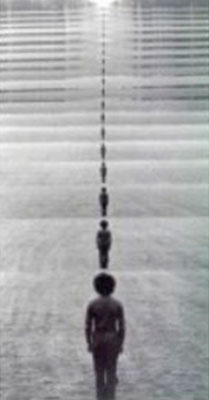
Klaus Rinke, 1972.
Other examples exploit the replication made possible by photography are the sequential arrangements of figures favored by German photographers Floris M Neusus, Klaus Rinke, and Manfred Willman and Dutch graphic artist Ger Dekkers. Polish photographer Andrzej Lachowicz bring to mind the multiple images of the 19th-century carte-de-visite.
Working on a grand scale has attracted straight photographers as well as those involved with manipulation or directorial strategies. Included Richard Avedon, Robert Mapplethorpe, and Cindy Sherman.
A number of European photographers have expanded the size of their work and share the conviction that by itself the single straight documentary photograph is not adequate for their expressive purposes.
Gilbert and George in Britain, Joseph Beuys, Andreas Gursky and Thomas Struth have all chosen to work in dimensions that range between four and nine feet.

Matthew, 1963. Ken Josephson.
Conceptual photographers do not always work with sequential images such as Kenneth Josephson showing a photograph within a photograph.
Investigating the relation of photograph to reality had antecedents in Alfred Stieglitz’s work in 1886 Sun’s Rays.
Alluded to the characteristics and potentials of the medium by including a variety of camera pictures of the sitter made at other times and in different positions.
In the 1980s, the approach to art-making known as Postmodernism evolved from the Conceptual art of the previous decade.
Represented a largely unsuccessful effort to counter the transformation of the photograph from document into aesthetic commodity.
Sought to formulate a new relationship between the camera image and social realities. Claimed that camera images of real life could not claim uniqueness because they replicate something that already exists.

Untitled (President: 4), 1979. Sherrie Levine.
Proposed that neither photographer nor viewer can reach beyond the shared cultural patterns of their time to invest the camera image with a timeless aesthetic character or an emotional tone that will be invariable understood by all, the photographer should endeavor instead to provide thought about current social phenomena.
A number of different way s to express ironic attitudes toward cultural stereotypes in general and toward the particular claims of the photograph as a highly valued aesthetic object.
Sherrie Levine rephotographed well-known photographic images and Richard Prince sought to impugn the modernist idea of the artist-photographer as a charismatic figure with unique creative powers.
Postmodern strategies ran a gamut from mimicking films stills and high-gloss advertising photographs such as Cindy Sherman’s portraits of herself in a variety of guises, to arranging scenes in which live models or dolls imitate photographic illustrations in consumer magazines or impersonate real-life situations, as in Laurie Simmon’s tableaus.
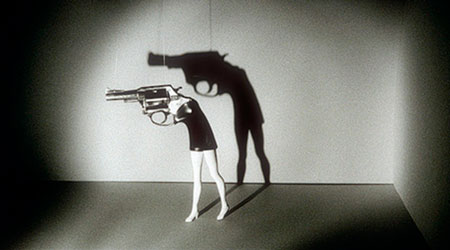
Walking Gun. Laurie Simmons.
Sandy Skoglund’s interiors full of animal and human forms that she sculpted, posed, and painted in unnatural colors were intended to show “what it’s like to live in America at this time.”
Another postmodern approach recalls the idea of deforming the image prevalent during the late 1920s and 1920s. Hanna Hoch’s Cut of the Kitchen Knife endeavored to “deconstruct” the myths of contemporary society by using found photographs and attaching texts intended to make the viewer aware of attitudes implicit in the popular media.

Made for a party. Hannah Hoech.
Victor Burgin appended his own messages, set in type, to photographs of common scenes which he then rephotographed. Maneuvers were meant to reposition such imagery in the viewer’s awareness, bringing to light underlying consumerist and sexist messages, rather than appealing to feelings or a sense of beauty.
Helped women photographers investigate the ways their lives were being transformed into stereotypes in the commercial media and examined women’s own needs and roles.
Barbara Kruger addressed issues of male domination and the dynamics of power by adding her own captions, often composed of cutout letters, to large-scale images whose graininess mimicked that of newspaper ads.
Other explorations include French photographer Sophie Calle, and a Moroccan photographer Lalla Essaydi make a statement about the role of women.
Interventions in the physical production of camera images and manipulation of the chemicals and later, electronic processes have taken various forms, all of which have as their central principle the freedom of the photographer to be as spontaneous and inventive as the graphic artists while preserving the replicative aspects of the medium.
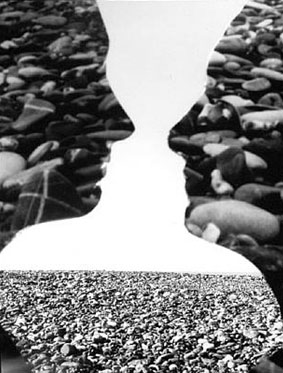
Two Faces Are A Vase, 1985. Ruth Thorne-Thomsen.
Choosing to use a camera with a pinhole instead of a lens is a simple means of adjusting the photographic process to one’s expressive needs such as the case with the strangely elegiac landscapes by Ruth Thorne-Thomsen.
A different kind of camera lens can also provide photographers with a creative tool either by giving actual scenes a sense of unreality through subtle distortion or by dramatically deforming expression and gesture. Berenice Abbott and Weegee distorted figures and objects using special lenses.
Bill Brandt’s extremely wide-angle lenses emerged as a resolved body of work.
Christian Vogt related closely to classical Surrealism and employed wide-angle lenses to invest both ordinary scenes and staged enactments with an unnerving sense of infinite depth.
Distortion has become a distinctive element of expression in the work of many creative and fashion photographers. Other techniques included cameraless images with extensive intervention in the optical process such as photograms or light graphics.
Photographic collage involves cropping and recombining camera images, either original or reproduced, by physically gluing them together while montage refers to uniting images in the enlarger or in the computer.
Jaromir Stephany experimented with similar techniques and used ink on film in both 4x5” and 35mm formats to create visionary images that suggest galactic events.
Possibilities of cliche verre appealed to Frederick Sommer who began to work with glass and cellophane in the 1950s, painting or fuming these materials with smoke to create nonobjective shapes. Sought to give visible form to the mysteries he discovered in both real and imaginary worlds. Regarded both as the same.
Printing multiple images on one photographic support had enabled the exploration of mystical realms that seemed impossible to evoke through straight photographs.
William Mortensen imagined scenes that seemed at once bizarre and amusing to many contemporaries, resorted to montage to create his visions of wickedness and lust.
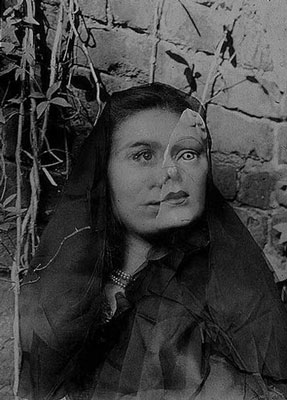
The Masks Grow to Us, 1947. Clarence John Laughlin.
Clarence John Laughlin, bemused by the “unreality of the real and the reality of the unreal,” worked with montage and created settings, costumed models, and directed scenarios to give form to his conviction that “the physical object is merely a stepping stone to an inner world.”
Edmund Teske combined chemical manipulations with montage to make poignant his sense of the melancholy eroticism of small town American life.
Over the past several decades Barbara Crane worked with cropped and repeated strips of images of built structures and organic matter. Combined them with other experimentalist elements such as photographs.
Joyce Neimanas collaged Polaroid prints to extend the biographical data about her subjects by incorporating images of their belongings and surroundings.
Carl Chiarenza created miniature still lifes from torn paper and photographic packaging materials that he then photographed; enlarged greatly, these works take on the aspect of mysterious landscapes.
Both collage and montage were seen as especially fruitful methods of projecting private visions.
Jerry Uelsmann has written “the mind knows more than the eye and camera can see.”

Untitled 1982. Jerry Uelsmann.
Uelsmann is one of a group of photographers who, since the 1960s, have consistently used montage to create poetic fantasies. Pieced together from an array of his own negatives, his work achieves a seamless merging of the real and the imagined. Early images express perception of women as fertility figures from whom all life radiate.
Japanese photographer Eikoh Hosoe reflects the belief that the camera has introduced him to an “abnormal, warped, sarcastic, grotesque, savage and promiscuous world.”
Montages by California photographer Robert Heinecken are full of gritty allusions to the often violent sexism rampant on magazine pages, billboards and television screens.
Czech photographers Martin Hruska and Jan Saudek create dreamlike visions and erotic statements by staging scenes and combing images in the enlarger. Recalls spatial configurations and symbols invented by painters Salvador Dali and de Chirico.
Dutch filmmaker addressed the excesses of consumerist culture by staging and montaging outrageous parodies of bourgeois fetishes and by printing his images in a grainy style that mimics cheap print reproduction.
The Germans Rinke and Willman and the Italian photographer Franco Vaccari combined complete or partial photographs of the same object place or individual taken from different vantage points and at different times.
Aim was to suggest the “incomplete, unstable and unending forms that reality assumes,” and to provide images with such large dimensions that they require the viewer to include times as an element in their perception of them.
In societies such as Egypt, England, Italy and Russia, digitization enabled photographers to embrace the possibilities inherent in montage in order to express the profound sense of instability they experienced as their countries grew more chaotic or underwent catastrophic economic and social change.
Extensive use of models acting out scenes in fabricated settings that suggest the irrational content of dreams and visions is another singular change that occurred in photography since the 1960s. Ralph Eugene Meatyard photographed family and friends posed in unpretentious settings with psychological nuances.
M. Richard Kirstel, Les Krims, Laurie Simmons, Arthur Tress, Joel-Peter Witkin, de Nooijer, Bernard Faucon, Joan Fontcuberta and Jan Saudek created fantasies that are entirely fabricated. Krims used iconography of both Surrealism and Pop art in his sardonic and at times horrifying statements about middle-class life in modern America.
Jean Dieuzaide and Denis Brihat photographed abstract shapes and forms suggestive of human anatomy.
Lucien Clergue posed nude models in a landscape of sea and sand for close-up views that ostensibly are evocations of mythic earth goddesses.
Hiroshi Sugimoto has taken mechanism that once served as teaching models for engineering students and through lighting and close-up has imbued them with a mysterious sense.


